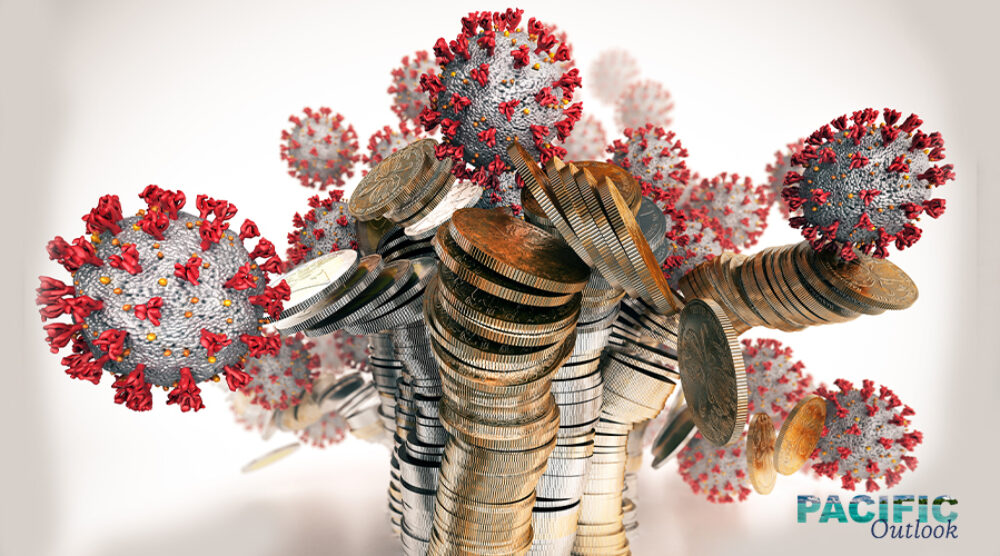The effects of COVID-19 on global economies is described very well in just one word—one which now has become synonymous with the pandemic—“unprecedented”! In the OECD area, the average fall in real gross domestic product (GDP) was an “unprecedented” -9.8 per cent (provisional) in the second quarter of 2020. The fall was most dramatic in the United Kingdom at -20.4 per cent. In light of this, one can only imagine how things might be in the Pacific island countries (PICs). As elsewhere, here too, the important discussions would have to be on economic recovery—certainly a long haul for the region. In the meantime, several measures have been taken by governments, central banks and others to keep economies afloat. As always, assistance from multilateral bodies such as International Monetary Fund (IMF), Asian Development Bank (ADB) and the World Bank Group (WBG) has been phenomenal. This article, for the purposes of information sharing in the region, summarises the key responses for some PICs to date and raises some policy-related questions for debate and deliberations.
PICs respond
In Papua New Guinea, for example, the central bank has reduced the kina facility rate from 5 per cent to 3 per cent and cash reserve requirement from 10.0 per cent to 7.0 per cent to facilitate liquidity. Other forms of liquidity assistance such as increasing money supply through open market operations, deferring loan payments and reducing lending rates have also been initiated. The Fijian Government has announced stimulus packages aimed at protecting public health, supporting the economy and ensuring food security. The policy rate has been reduced to 0.25 per cent to keep the private sector afloat. The Natural Disaster and Rehabilitation Facility has been increased to FJ$60 million to provide concessional loans to commercial banks for them to lend to affected business. The government of Solomon Islands has adopted several COVID-19 economic stimulus packages to provide assistance to vulnerable households, firms and young people, including open market operations to buy back bonds to increase money supply and reduce the cash reserve rate from 7.5 per cent to 5.0 per cent. The government is also encouraging commercial banks to grant a grace period for all loan repayment. The Reserve Bank of Vanuatu cut its monetary policy rate from 2.9 per cent to 2.25 per cent to reduce the borrowing cost. About US$12.5 million stimulus package has been announced by the government to support the business sector. The Commodity Support Grant (300 million vatu) will be provided to support producers of copra, kava, coffee and cocoa. Timor-Leste has announced a stimulus package of US$150 million to manage economic and financial risks, measures include cash transfers and tax deferrals. The authorities also introduced a Credit Guarantee System for small enterprises, to extend the debt maturity by three months to debt holders and reduce the interest payments obligation to 40.0 per cent of the original amount and the remaining 60.0 per cent will be financed by the government.
Development partners respond
Working closely with the WBG, ADB and other regional partners, IMF has disbursed US$363.6 million under the Rapid Credit Facility (RCF) in emergency financing to Papua New Guinea. Solomon Islands has already received debt relief of US$19 million and has been approved for the disbursement of US$9.5 million in emergency financing under the RCF. Solomon Islands also received US$15 million funding from the World Bank through its Development Policy Operation to support the business sector and protect poor and vulnerable people. For Fiji, the World Bank has approved funding of US$7.4 million to strengthen its national health systems to prevent the virus spreading. Another US$952380 million Pandemic Emergency Financing Facility Grant has been approved to prevent, detect and respond to the threat posed by COVID-19. US$10 million emergency funding has been delivered by the World Bank to Vanuatu to support the country. This funding will assist Vanuatu’s economic recovery and protect local people from the pandemic. The US$10 million will be delivered through a Development Policy Grant with a catastrophe-deferred drawdown option. Timor-Leste has received assistance from the Australian government through receiving protective equipment and medical supplies for healthcare workers.
Where to from here?
Most actions, policy responses and assistance in, and to, the PICs to date can be argued to be largely for the purposes of keeping economies afloat and to manage the spread of the virus. Many questions arise. For example, are there going to be medium to long-term solutions and responses as well? Will these be founded in evidence-based academic research? Will the PICs continue to focus on sectors that have contributed substantially to GDP, such as tourism? Revival of the tourism industry will depend on recommencement of international flights. Aussies and Kiwis are among the major sources. Flights from here are not likely to commence for a few more months—perhaps several. Then, will tourists be eager to fly? When? Will the region continue to depend on international remittances for household survival? Remittance benefactors are out of jobs and struggling with their own expenses, including mortgage payments. Is it time to go back to the drawing board and look at strategies—and the future—through a new lens? Perhaps, it is. Perhaps, a new wave of thinking and vision is required for the region. Where will it come from? In times like these, we certainly do need some “paradigm shift” and courage and political will to steer economies in a new direction. Regional solutions might also be a way forward.

Dr Tong Tong is an Early Career Researcher, having recently been awarded a PhD. Tong is also actively involved in the SPCCB program. For more articles on PIC economies, see Pacific Forum.








